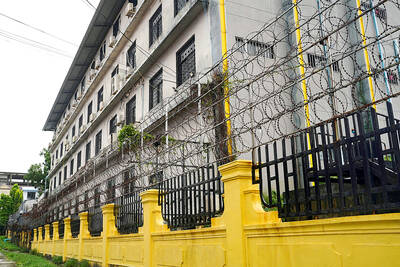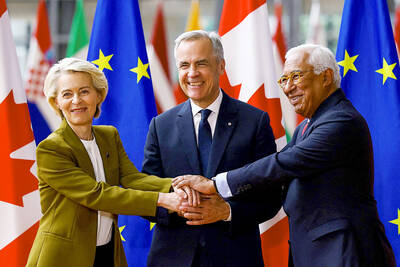It used to be the stuff of 2000AD, the comic that introduced the world to Judge Dredd and two vast crime-filled cities, Mega City One and East Meg One.
In its dystopian vision, the first mega city around New York began construction in 2030, intended to house three to four million people. In a sign of how quickly future dystopias age, the new Times Atlas of the World lists the growing club of real mega cities, all of them with predicted populations of more than 10 million -- not by 2030, but by 2005.
According to these estimates, Tokyo -- the world's largest city -- will hit nearly 27 million. Sao Paolo in Brazil will have just under 20 million people and Mexico City 19 million. Sixteen other cities are expected to exceed the 10 million mark, including Mumbai with 18 million and Dhaka in Bangladesh with 15 million residents.
Two cities in Africa are expected to go mega -- Lagos in Nigeria and Cairo in Egypt. According to the atlas -- the 11th edition since it was first published in 1895 -- the phenomenon is a mark of a global population in the grips of rapid urbanization, where close to 50 per cent of the population now lives in cities.
Indeed, the latest estimates predict that urban dwellers will outnumber the rural population for the first time by 2007.
And Tokyo is leading the way. A Landsat 7 image of the city, included in the atlas, shows the city's growth, a spreading grey cancer whose spiralling tendrils can be seen sucking in neighboring cities and towns and even reclaimed sea.
The rise of the world's mega cities is one of the most marked trends noted by the atlas in recent decades. It has been a process driven largely by Asia -- the continent boasting 10 mega cities by 2000, while North America had managed two (New York City and Los Angeles).
But the mega cities are not the only major human impact noted by the atlas. There has also been a catastrophic impact on the environment. The atlas's authors estimate that 90,000km2 of forest is being lost each year, the equivalent, since the last edition of the atlas in 1999, of an area the size of the British Isles.
But the greatest impact has come through global warming, with successive editions of the atlas showing shrinking ice fields and evaporating lakes. It reveals the rapid retreat of the Aral Sea in Kazakhstan and Uzbekistan, once the world's fourth largest lake and now the tenth.
Since the 1967 edition of the atlas it has shrunk by 39,994km2.
Since the 1975 edition, the surface of the Dead Sea has dropped by a massive 17m.
It is the availability of new digital satellite technology that has made the changes so shockingly apparent.
The atlas's chief cartographer, Sheena Barclay, said: "We are seeing things that you would not have seen 10 or even 15 years ago, changes that we can see by overlaying versions of our satellite images. And we are seeing a lot of concerning things."
Perhaps the most compelling evidence of global climate change came during the preparation of the present volume when the cartographers had to redraw the coastline of Antarctica after the Larsen ice shelf disintegrated last year.

Drug lord Jose Adolfo Macias Villamar, alias “Fito,” was Ecuador’s most-wanted fugitive before his arrest on Wednesday, more than a year after he escaped prison from where he commanded the country’s leading criminal gang. The former taxi driver turned crime boss became the prime target of law enforcement early last year after escaping from a prison in the southwestern port of Guayaquil. Ecuadoran President Daniel Noboa’s government released “wanted” posters with images of his face and offered US$1 million for information leading to his capture. In a country plagued by crime, members of Fito’s gang, Los Choneros, have responded with violence, using car

CYBERCRIME, TRAFFICKING: A ‘pattern of state failures’ allowed the billion-dollar industry to flourish, including failures to investigate human rights abuses, it said Human rights group Amnesty International yesterday accused Cambodia’s government of “deliberately ignoring” abuses by cybercrime gangs that have trafficked people from across the world, including children, into slavery at brutal scam compounds. The London-based group said in a report that it had identified 53 scam centers and dozens more suspected sites across the country, including in the Southeast Asian nation’s capital, Phnom Penh. The prison-like compounds were ringed by high fences with razor wire, guarded by armed men and staffed by trafficking victims forced to defraud people across the globe, with those inside subjected to punishments including shocks from electric batons, confinement

The team behind the long-awaited Vera Rubin Observatory in Chile yesterday published their first images, revealing breathtaking views of star-forming regions as well as distant galaxies. More than two decades in the making, the giant US-funded telescope sits perched at the summit of Cerro Pachon in central Chile, where dark skies and dry air provide ideal conditions for observing the cosmos. One of the debut images is a composite of 678 exposures taken over just seven hours, capturing the Trifid Nebula and the Lagoon Nebula — both several thousand light-years from Earth — glowing in vivid pinks against orange-red backdrops. The new image

Canada and the EU on Monday signed a defense and security pact as the transatlantic partners seek to better confront Russia, with worries over Washington’s reliability under US President Donald Trump. The deal was announced after a summit in Brussels between Canadian Prime Minister Mark Carney and European Commission President Ursula von der Leyen and European Council President Antonio Costa. “While NATO remains the cornerstone of our collective defense, this partnership will allow us to strengthen our preparedness ... to invest more and to invest smarter,” Costa told a news conference. “It opens new opportunities for companies on both sides of the